Abstract
Transfer of amyloidosis between syngeneic mice was attempted with whole spleen cells and homogenates, nuclei, cytoplasmic fractions and various preparations of nucleic acids. Amyloidosis could be transferred from casein-treated donor mice by means of spleen cell suspensions, homogenates or crude nuclei, but not with nuclei treated with DNase, cytoplasmic fractions or five different nucleic acid samples, derived from whole spleens or crude nuclei. The transfer activity of crude nuclei was lost after storage at 0 or –20°C. The experiments indicated that the amyloid inducing factor is a labile, complex substance, possibly a nucleoprotein.
Full text
PDF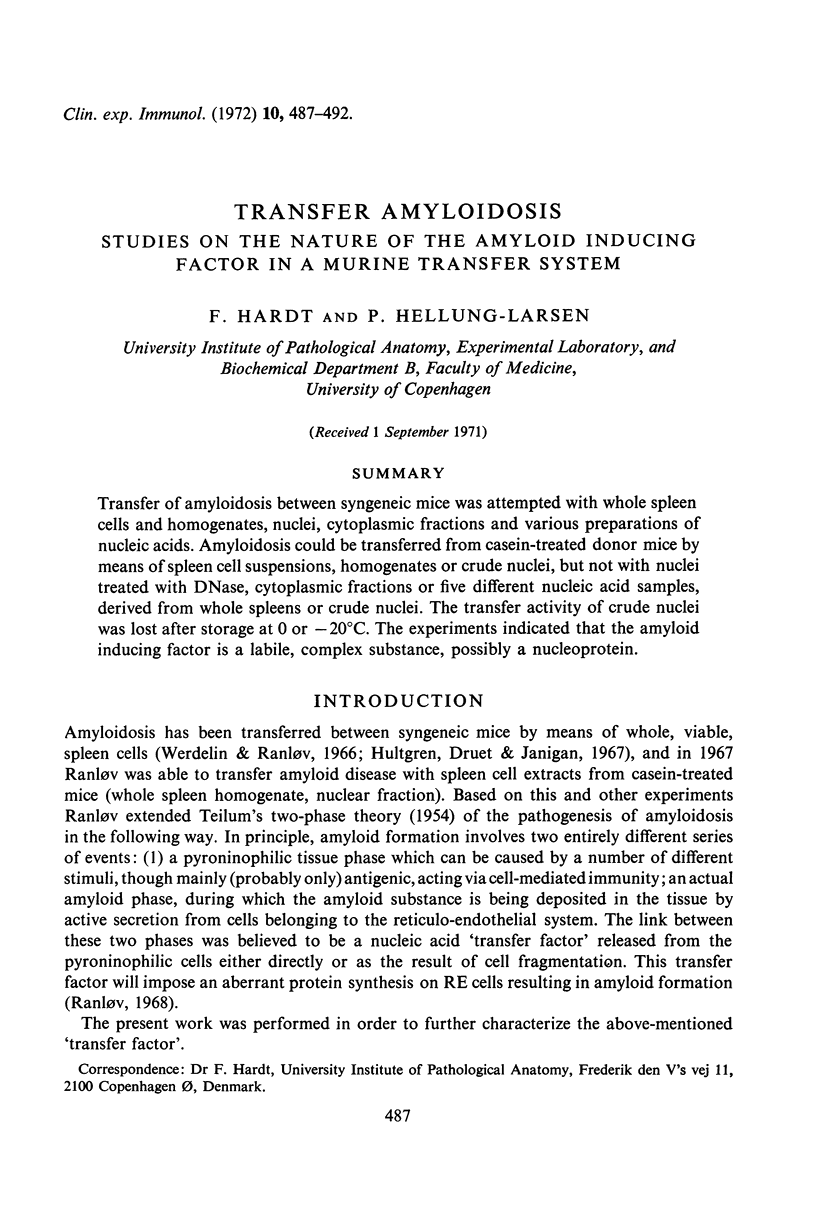
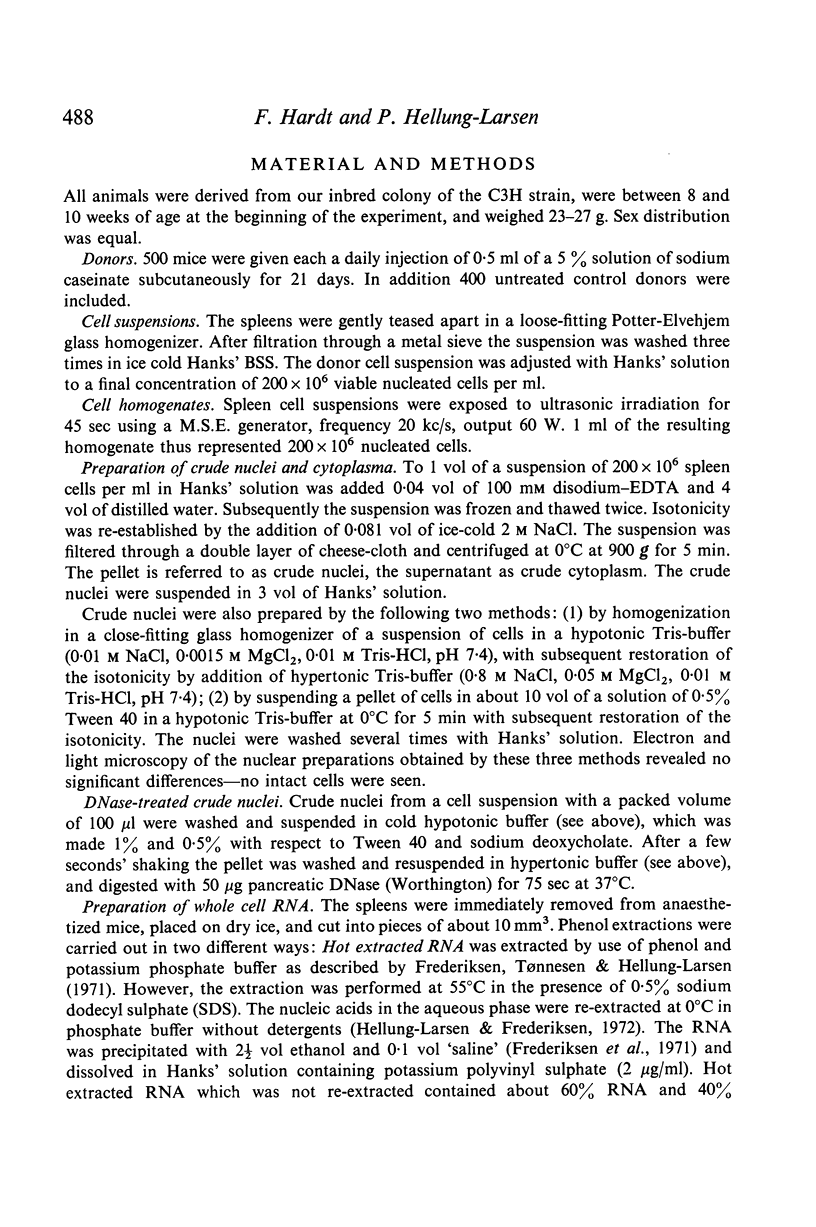

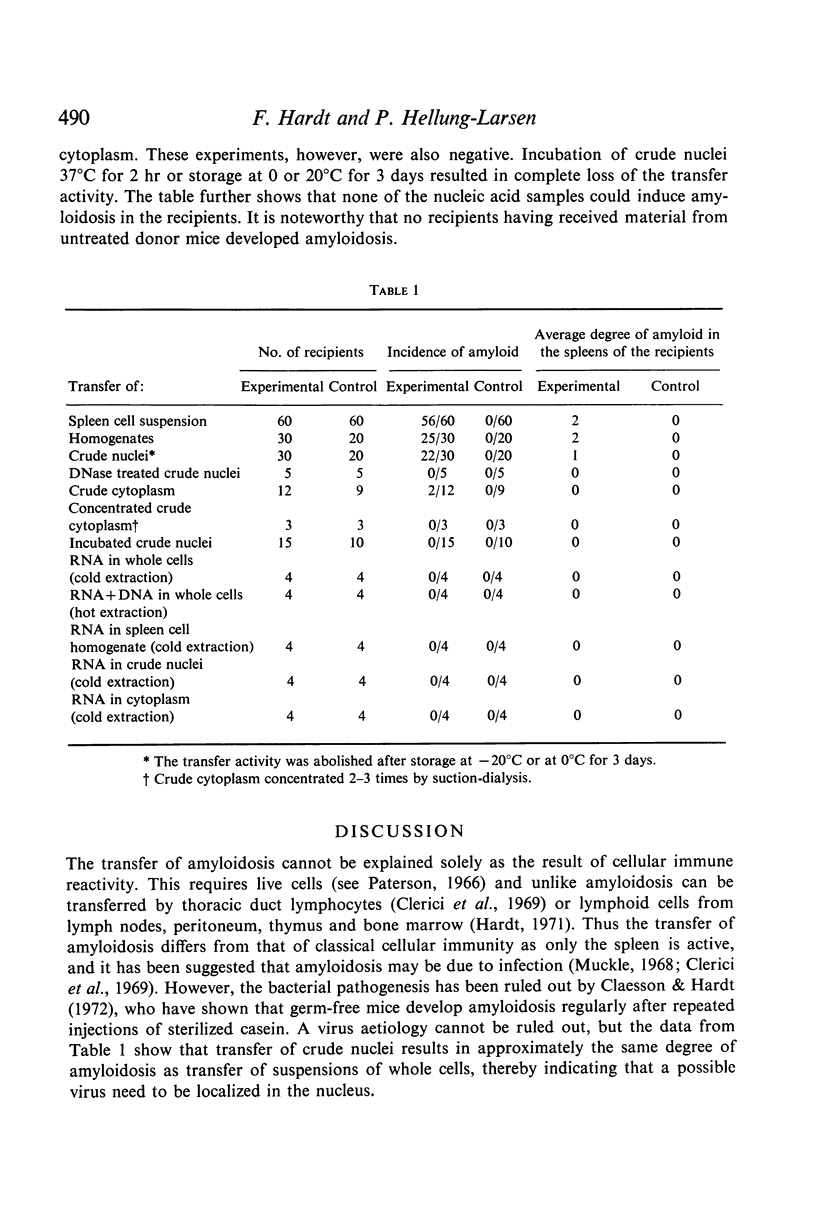
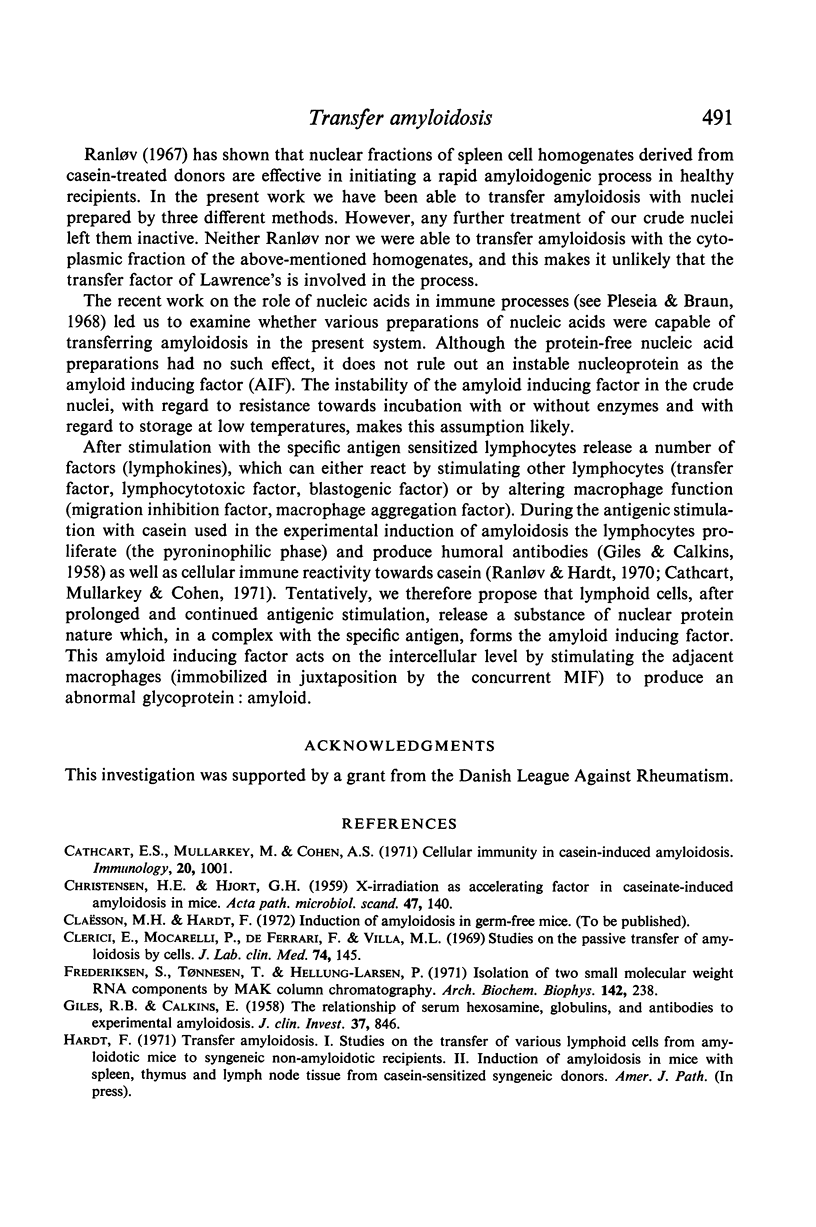
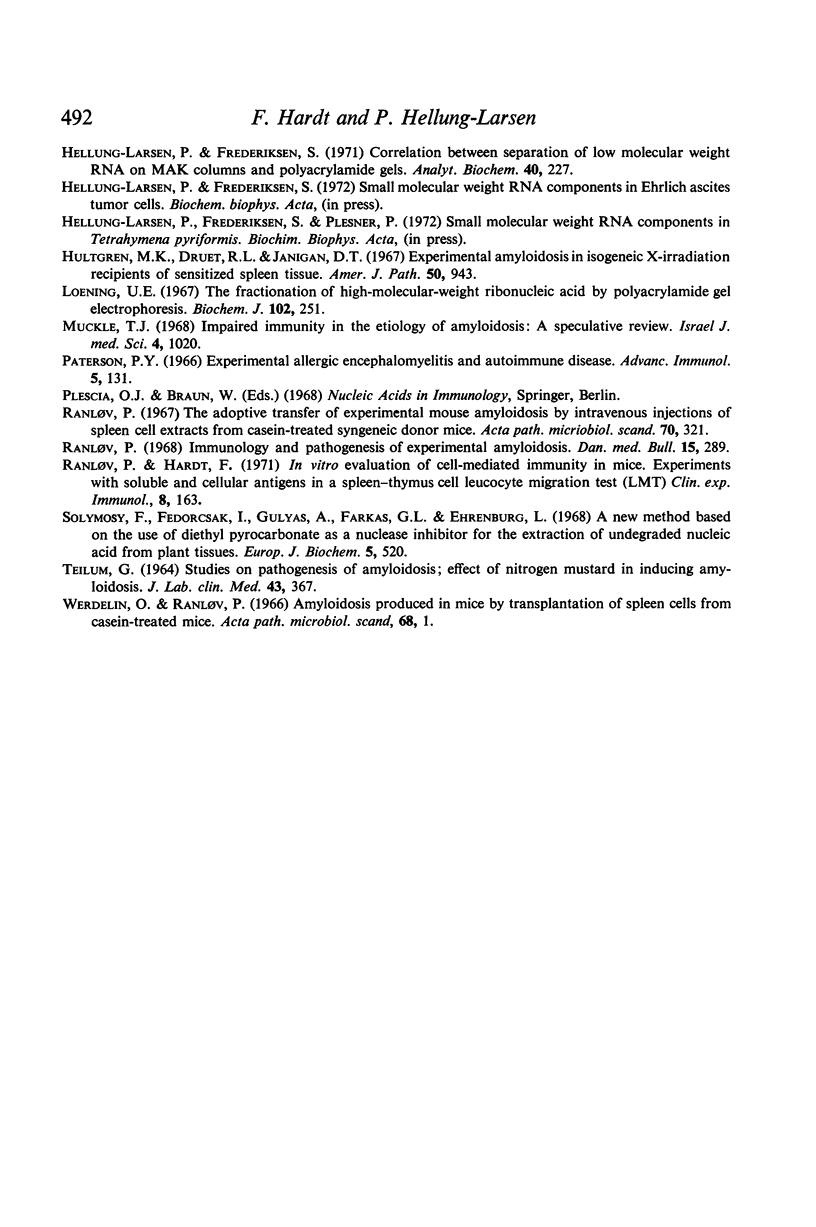
Selected References
These references are in PubMed. This may not be the complete list of references from this article.
- CHRISTENSEN H. E., HJORT G. H. X-irradiation as accelerating factor in caseinate-induced amyloidosis in mice. Acta Pathol Microbiol Scand. 1959;47:140–152. doi: 10.1111/j.1699-0463.1959.tb04842.x. [DOI] [PubMed] [Google Scholar]
- Cathcart E. S., Mullarkey M., Cohen A. S. Cellular immunity in casein-induced amyloidosis. Immunology. 1971 Jun;20(6):1001–1008. [PMC free article] [PubMed] [Google Scholar]
- Clerici E., Mocarelli P., De Ferrari F., Villa M. L. Studies on the passive transfer of amyloidosis by cells. J Lab Clin Med. 1969 Jul;74(1):145–152. [PubMed] [Google Scholar]
- Frederiksen S., Tonnesen T., Hellung-Larsen P. Isolation of two small molecular weight RNA components by MAK column chromatography. Arch Biochem Biophys. 1971 Jan;142(1):238–246. doi: 10.1016/0003-9861(71)90280-3. [DOI] [PubMed] [Google Scholar]
- GILES R. B., Jr, CALKINS E. The relationship of serum hexosamine, globulins, and antibodies to experimental amyloidosis. J Clin Invest. 1958 Jun;37(6):846–857. doi: 10.1172/JCI103675. [DOI] [PMC free article] [PubMed] [Google Scholar]
- Hellung-Larsen P., Frederiksen S. Correlation between separation of low molecular weight RNA on MAK columns and polyacrylamide gels. Anal Biochem. 1971 Mar;40(1):227–232. doi: 10.1016/0003-2697(71)90096-0. [DOI] [PubMed] [Google Scholar]
- Hultgren M. K., Druet R. L., Janigan D. T. Experimental amyloidosis in isogeneic x-irradiated recipients of sensitized spleen tissue. Am J Pathol. 1967 Jun;50(6):943–955. [PMC free article] [PubMed] [Google Scholar]
- Loening U. E. The fractionation of high-molecular-weight ribonucleic acid by polyacrylamide-gel electrophoresis. Biochem J. 1967 Jan;102(1):251–257. doi: 10.1042/bj1020251. [DOI] [PMC free article] [PubMed] [Google Scholar]
- Muckle T. J. Impaired immunity in the etiology of amyloidosis: a speculative review. Isr J Med Sci. 1968 Sep-Oct;4(5):1020–1034. [PubMed] [Google Scholar]
- Paterson P. Y. Experimental allergic encephalomyelitis and autoimmune disease. Adv Immunol. 1966;5:131–208. doi: 10.1016/s0065-2776(08)60273-4. [DOI] [PubMed] [Google Scholar]
- Ranlov P., Hardt F. In vitro evaluation of cell-mediated immunity in mice: experiments with soluble and cellular antigens in a spleen-thymus cell leucocyte migration test (LMT). Clin Exp Immunol. 1971 Feb;8(2):163–171. [PMC free article] [PubMed] [Google Scholar]
- Ranlov P. Immunology and pathogenesis of experimental amyloidosis. Dan Med Bull. 1968 Dec;15(10):289–296. [PubMed] [Google Scholar]
- Solymosy F., Fedorcsák I., Gulyás A., Farkas G. L., Ehrenberg L. A new method based on the use of diethyl pyrocarbonate as a nuclease inhibitor for the extraction of undegraded nucleic acid from plant tissues. Eur J Biochem. 1968 Sep 24;5(4):520–527. doi: 10.1111/j.1432-1033.1968.tb00401.x. [DOI] [PubMed] [Google Scholar]
- TEILUM G. Studies on pathogenesis of amyloidosis. II. Effect of nitrogen mustard in inducing amyloidosis. J Lab Clin Med. 1954 Mar;43(3):367–374. [PubMed] [Google Scholar]


